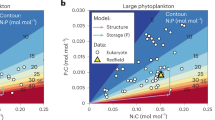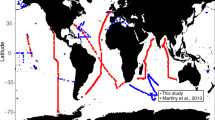Abstract
The average nitrogen-to-phosphorus ratio of marine phytoplankton (16N:1P) is closely matched to the nutrient content of mean ocean waters (14.3N:1P). This condition is thought to arise from biological control over the ocean’s nitrogen budget, in which removal of bioavailable nitrogen by denitrifying bacteria ensures widespread selection for diazotrophic phytoplankton that replenish this essential nutrient when it limits the growth of other species1,2,3. Here we show that in the context of a realistic ocean circulation model, and a uniform N:P ratio of plankton biomass, this feedback mechanism yields an oceanic nitrate deficit more than double its observed value. The critical missing phenomenon is diversity in the metabolic N:P requirement of phytoplankton, which has recently been shown to exhibit large-scale patterns associated with species composition4. When we model these variations, such that diazotrophs compete with high N:P communities in subtropical regions, the ocean nitrogen inventory rises and may even exceed the average N:P ratio of plankton. The latter condition, previously considered impossible, is prevented in the modern ocean by shallow circulations that communicate stoichiometric signals from remote biomes dominated by diatoms with low N:P ratios. Large-scale patterns of plankton diversity and the circulation pathways connecting them are thus key factors determining the availability of fixed nitrogen in the ocean.
This is a preview of subscription content, access via your institution
Access options
Subscribe to this journal
Receive 51 print issues and online access
$199.00 per year
only $3.90 per issue
Buy this article
- Purchase on Springer Link
- Instant access to full article PDF
Prices may be subject to local taxes which are calculated during checkout




Similar content being viewed by others
References
Redfield, A. C. The biological control of chemical factors in the environment. Am. Sci. 46, 205–221 (1958)
Redfield, A. C., Ketchum, B. H. & Richards, F. A. in The Sea Vol. 2 (ed. Hill, M. N. ) 26–77 (Interscience, 1963)
Deutsch, C. & Weber, T. Nutrient ratios as a tracer and driver of ocean biogeochemistry. Annu. Rev. Mar. Sci. 4, 113–141 (2012)
Weber, T. S. & Deutsch, C. Ocean nutrient ratios governed by plankton biogeography. Nature 467, 550–554 (2010)
Tyrrell, T. The relative influences of nitrogen and phosphorus on oceanic primary production. Nature 400, 525–531 (1999)
Karl, D. et al. Dinitrogen fixation in the world’s oceans. Biogeochemistry 57/58, 47–98 (2002)
Capone, D. G., Zehr, J. P., Paerl, H. W., Bergman, B. & Carpenter, E. J. Trichodesmium, a globally significant marine cyanobacterium. Science 276, 1221–1229 (1997)
Codispoti, L. A. in Productivity of the Ocean: Past and Present (eds Berger, W. H., Smetacek, V. S. & Wefer, G. ) 377–394 (John Wiley and Sons, 1989)
Ward, B. B. et al. Denitrification as the dominant nitrogen loss process in the Arabian Sea. Nature 461, 78–81 (2009)
Lam, P. & Kuypers, M. M. M. Microbial nitrogen cycling processes in oxygen minimum zones. Annu. Rev. Mar. Sci. 3, 317–345 (2011)
Lenton, T. M. & Watson, A. J. Redfield revisited. 1. Regulation of nitrate, phosphate, and oxygen in the ocean. Glob. Biogeochem. Cycles 14, 225–248 (2000)
Lenton, T. M. & Klausmeier, C. A. Biotic stoichiometric controls on the deep ocean N: P ratio. Biogeosciences 4, 353–367 (2007)
Quigg, A. et al. The evolutionary inheritance of elemental stoichiometry in marine phytoplankton. Nature 425, 291–294 (2003)
Green, S. E. & Sambrotto, R. N. Plankton community structure and export of C, N, P and Si in the Antarctic Circumpolar Current. Deep Sea Res. II 53, 620–643 (2006)
Arrigo, K. R. et al. Phytoplankton community structure and the drawdown of nutrients and CO2 in the Southern Ocean. Science 283, 365–367 (1999)
Berman-Frank, I., Cullen, J. T., Shaked, Y., Sherrell, R. M. & Falkowski, P. G. Iron availability, cellular iron quotas, and nitrogen fixation in Trichodesmium. Limnol. Oceanogr. 46, 1249–1260 (2001)
Kustka, A., Carpenter, E. J. & Sanudo-Wilhelmy, S. A. Iron and marine nitrogen fixation: progress and future directions. Res. Microbiol. 153, 255–262 (2002)
DeVries, T., Deutsch, C., Primeau, F., Chang, B. & Devol, A. Global rates of water-column denitrification derived from nitrogen gas measurements. Nature Geosci. 5, 547–550 (2012)
Heldal, M., Scanlan, D. J., Norland, S., Thingstad, F. & Mann, N. H. Elemental composition of single cells of various strains of marine Prochlorococcus and Synechococcus using X-ray microanalysis. Limnol. Oceanogr. 48, 1732–1743 (2003)
Bertilsson, S., Berglund, O., Karl, D. M. & Chisholm, S. W. Elemental composition of marine Prochlorococcus and Synechococcus: implications for the ecological stoichiometry of the sea. Limnol. Oceanogr. 48, 1721–1731 (2003)
Karl, D. M. et al. Ecological nitrogen-to-phosphorus stoichiometry at station ALOHA. Deep Sea Res. II 48, 1529–1566 (2001)
Klausmeier, C. A., Litchman, E., Daufresne, T. & Levin, S. A. Optimal nitrogen-to-phosphorus stoichiometry of phytoplankton. Nature 429, 171–174 (2004)
Deutsch, C., Sarmiento, J. L., Sigman, D. M., Gruber, N. & Dunne, J. P. Spatial coupling of nitrogen inputs and losses in the ocean. Nature 445, 163–167 (2007)
Mills, M. M. & Arrigo, K. R. Magnitude of oceanic nitrogen fixation influenced by the nutrient uptake ratio of phytoplankton. Nature Geosci. 3, 412–416 (2010)
Codispoti, L. A. Biogeochemical cycles—is the ocean losing nitrate? Nature 376, 724 (1995)
Falkowski, P. G. Rationalizing elemental ratios in unicellular algae. J. Phycol. 36, 3–6 (2000)
Broecker, W. S. & Henderson, G. M. The sequence of events surrounding Termination II and their implications for the cause of glacial-interglacial CO2 changes. Paleoceanography 13, 352–364 (1998)
Polovina, J. J., Howell, E. A. & Abecassis, M. Ocean’s least productive waters are expanding. Geophys. Res. Lett. 35, L03618 (2008)
DeVries, T. & Primeau, F. Dynamically and observationally constrained estimates of water-mass distributions and ages in the global ocean. J. Phys. Oceanogr. 41, 2381–2401 (2011)
Khatiwala, S. A computational framework for simulation of biogeochemical tracers in the ocean. Glob. Biogeochem. Cycles 21 10.1029/2007GB002923 (2007)
Garcia, H. E., Locarni, R. A., Boyer, T. P. & Antonov, J. I. World Ocean Atlas 2005 Vol. 4 Nutrients (phosphate, nitrate, silicate) (US Government Printing Office, 2006)
Mahowald, N. M. et al. Change in atmospheric mineral aerosols in response to climate: last glacial period, preindustrial, modern, and doubled carbon dioxide climates. J. Geophys. Res. 111 10.1029/2005JD006653 (2006)
Martin, J. H., Gordon, R. M., Fitzwater, S. & Broenkow, W. W. VERTEX: phytoplankton/iron studies in the Gulf of Alaska. Deep-Sea Res. 36, 649–680 (1989)
Middelburg, J. J., Soetaert, K., Herman, P. M. J. & Heip, C. H. R. Denitrification in marine sediments: a model study. Glob. Biogeochem. Cycles 10, 661–673 (1996)
Egge, J. K. & Aksnes, D. L. Silicate as regulating nutrient in phytoplankton competition. Mar. Ecol. Prog. Ser. 83, 281–289 (1992)
Jin, X., Gruber, N., Dunne, J. P., Sarmiento, J. L. & Armstrong, R. A. Diagnosing the contribution of phytoplankton functional groups to the production and export of particulate organic carbon, CaCO3, and opal from global nutrient and alkalinity distributions. Glob. Biogeochem. Cycles 20 10.1029/2005GB002532 (2006)
Brzezinski, M. A. et al. A switch from Si(OH)4 to NO3-depletion in the glacial Southern Ocean. Geophys. Res. Lett. 29, 1564 (2002)
Sarmiento, J. L. & Gruber, N. Ocean Biogeochemical Dynamics (Princeton University Press, 2006)
Alvain, S., Moulin, C., Dandonneau, Y. & Loisel, H. Seasonal distribution and succession of dominant phytoplankton groups in the global ocean: a satellite view. Glob. Biogeochem. Cycles 22 10.1029/2007GB003154 (2008)
Kwon, E. Y. & Primeau, F. Optimization and sensitivity study of a biogeochemistry ocean model using an implicit solver and in situ phosphate data. Glob. Biogeochem. Cycles 20 10.1029/2005GB002631 (2006)
Acknowledgements
We thank T. DeVries for providing the ocean circulation model. This work was funded by a NASA Earth Systems Science Fellowship (T.W.) and a grant from the Gordon and Betty Moore Foundation (C.D.).
Author information
Authors and Affiliations
Contributions
T.W. developed the model and performed simulations and analyses. Both authors designed the study and wrote the paper.
Corresponding author
Ethics declarations
Competing interests
The authors declare no competing financial interests.
Supplementary information
Supplementary Information
This file contains Supplementary Notes that discuss sensitivity testing and additional considerations to support the conclusions, Supplementary Figures 1-10, which illustrate the methods and present additional sensitivity testing results and Supplementary Tables 1-2. Supplementary Table 1 gives parameter values used in the ecosystem/biogeochemistry model and Supplementary Table 2 presents the results of the dissolved organic matter sensitivity tests. (PDF 2415 kb)
Rights and permissions
About this article
Cite this article
Weber, T., Deutsch, C. Oceanic nitrogen reservoir regulated by plankton diversity and ocean circulation. Nature 489, 419–422 (2012). https://doi.org/10.1038/nature11357
Received:
Accepted:
Published:
Issue Date:
DOI: https://doi.org/10.1038/nature11357
This article is cited by
-
Global patterns and predictors of C:N:P in marine ecosystems
Communications Earth & Environment (2022)
-
Global patterns in marine organic matter stoichiometry driven by phytoplankton ecophysiology
Nature Geoscience (2022)
-
The Angola Gyre is a hotspot of dinitrogen fixation in the South Atlantic Ocean
Communications Earth & Environment (2022)
-
Phosphorus as an integral component of global marine biogeochemistry
Nature Geoscience (2021)
-
Nitrogen isotopic constraints on nutrient transport to the upper ocean
Nature Geoscience (2021)
Comments
By submitting a comment you agree to abide by our Terms and Community Guidelines. If you find something abusive or that does not comply with our terms or guidelines please flag it as inappropriate.



